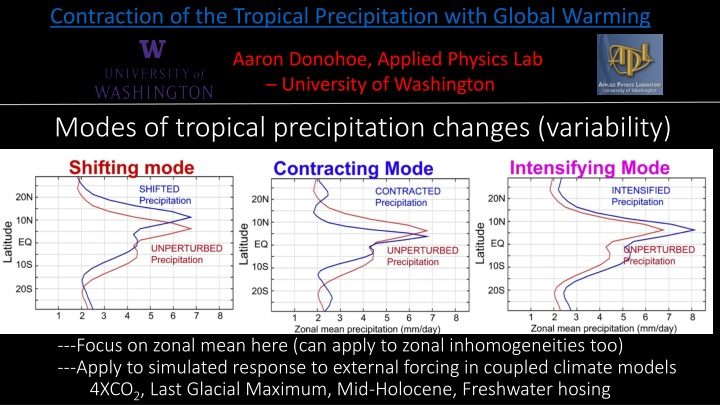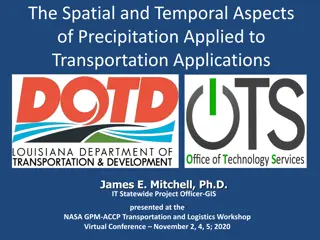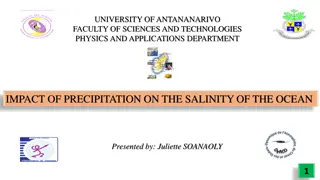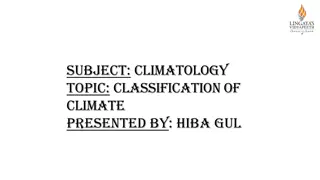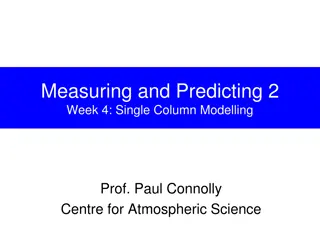Contractions of Tropical Precipitation Under Global Warming
Aaron Donohoe's research focuses on the contraction of tropical precipitation with global warming, emphasizing the zonal mean and its implications for climate models. The results show a robust contraction and intensification of tropical precipitation in a warmer world. The width of tropical precipitation in the annual mean is determined by the distribution and bimodal nature of precipitation. The role of the seasonal cycle in stretching out the annual mean precipitation is highlighted, emphasizing the control of the width of tropical precipitation by the seasonal range of ITCZ migration.
Download Presentation

Please find below an Image/Link to download the presentation.
The content on the website is provided AS IS for your information and personal use only. It may not be sold, licensed, or shared on other websites without obtaining consent from the author.If you encounter any issues during the download, it is possible that the publisher has removed the file from their server.
You are allowed to download the files provided on this website for personal or commercial use, subject to the condition that they are used lawfully. All files are the property of their respective owners.
The content on the website is provided AS IS for your information and personal use only. It may not be sold, licensed, or shared on other websites without obtaining consent from the author.
E N D
Presentation Transcript
Contraction of the Tropical Precipitation with Global Warming Aaron Donohoe, Applied Physics Lab University of Washington Modes of tropical precipitation changes (variability) ---Focus on zonal mean here (can apply to zonal inhomogeneities too) ---Apply to simulated response to external forcing in coupled climate models 4XCO2, Last Glacial Maximum, Mid-Holocene, Freshwater hosing
An example : change in precipitation under 4XCO2 SHIFT Initial and target precip. with all modes optimized CONTRACT INTENSIFIED
Results: Shifting, contracting and intensifying tropical precip. ITCZ Shifts explain very little of tropical precipitation changes; contractions and intensification explain more Contraction and intensification are highly coupled and there is a robust contraction and intensification in a warmer world and expansion reduction in a cooler world with fixed ratio Take the contraction and intensifying ratio as empirical. We can then describe the tropical precipitation shift with two modes: shifting and intensifying/contract with little loss of explanatory power ITCZ Shifts are: (1) small in magnitude (2) explain little precip. Change (3) not robust with climate change
What determines the width of tropical precipitation in the annual mean? Distribution of tropical precipitation is bimodal Like a sine wave ITCZ is seldom in annual mean location Annual mean precipitation is the statistical average of precipitation during solsticial seasons
Role of seasonal cycle in stretching out the annual mean precipitation GFDL aquaplanet with seasonal insolation coupled to slab ocean (Dargan) Change depth of slab (50m to 2.4 m --globally uniform) Amplitude of seasonal ITCZ migration off the equator controls the width of the tropics!
Width of tropical precipitation controlled by seasonal range of ITCZ migration
Contraction of tropical precipitation under global warming is equivalent to reduced seasonal migration of ITCZ
Previous work has demonstrated that annual mean ITCZ location is dictated by annual mean inter-hemispheric heat transport (Frierson Hwang 2012, Donohoe et al. 2013 many others) CLAIM: Seasonal amplitude (range) of cross equatorial energy transport dictates seasonal migration of ITCZ off equator tropical width
Reduced seasonal migration of the ITCZ (tropical contraction) under global warming: Is NOT a consequence of reduced seasonality of energy transport across the equator (range on abscissa) Results from reduction of slope between ITCZ location and energy transport ITCZ (and Hadley cell) migrates less far from the equator to achieve a given energy transport
SUMMARY Tropical precipitation robustly contracts and intensifies in a warmer world and expands and reduces in a colder world dominant mode of tropical precipitation variability and changes under external forcing Width of tropics set by seasonal migration of ITCZ off the equator Amplitude of seasonal energy input the atmosphere Speculation: Under global warming tropopause rising and increased gross moist stability of the tropics means the ITCZ (and Hadley cell) don t have to move as far off the equator to satisfy seasonal energy constraints
